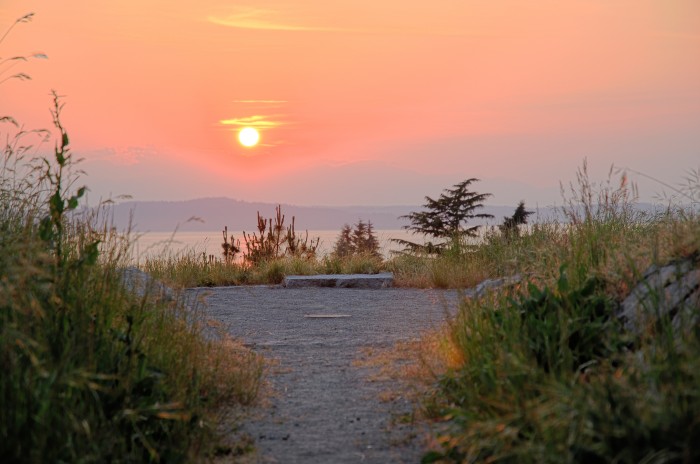Archive for March, 2011
 Seasons “Cheat Sheet”
Seasons “Cheat Sheet”
WARNING: THIS POST IS OVERWHELMING. There is too much information in one place, but I promise there are fun and interesting gems hidden within. It is meant as a reference, and a starting point for discussion of each of these topics.
There are a few numbers and references I am often asked for, especially at the West Seattle solstice and equinox sunset watches. I thought I’d collect these things in one place for “easy” reference.
Strict Definitions (from the USNO)
Equinox – The time at which the Sun passes through one of the two points on the celestial sphere where the celestial equator and the ecliptic intersect. (Yup, pretty technical – the non-technical version is “when the Earth’s axis is pointed neither towards nor away from the Sun.”)
Solstice – The time at which the Sun is at either of the two points on the ecliptic at which the longitude of the Sun is 90° or 270° (halfway between the equinoxes). The non-technical version is “when the Earth’s axis is pointed exactly towards or exactly away from the Sun.”
Horizon – Your eye is considered to be the surface of the Earth, so the horizon is the line exactly straight out from your eyes, or exactly 90 degrees down from the point directly above your head.
Sunrise and Sunset – When “the upper edge of the disk of the Sun is on the horizon, considered unobstructed” (calculations assume a flat horizon). To calculate this exactly, one assumes that this occurs when the Sun is 90.8333° from the zenith (0.8333° below the horizon as defined above). The extra 0.8333° take into account both the radius of the Sun’s disk and an average amount of refraction due to the atmosphere.
Two more notes on rise and set times. First, atmospheric refraction is very important, and small changes in the quality of the atmosphere (humidity, cloud layers, etc) can change apparent rise and set times by at least a minute. Also “at high latitudes … small variations in atmospheric refraction can change the time of rise or set by many minutes, since the Sun and Moon intersect the horizon at a very shallow angle.”
Twilight – there are a few different types of twilight.
Civil Twilight – When the center of the Sun is 6° below the horizon. You can still see during civil twilight, and may not need to turn on outdoor lights. The brightest stars become visible at the beginning or end of civil twilight (“Star light, star bright, first star I see tonight …” you’re still in civil twilight).
Nautical Twilight – When the center of the Sun is 12° below the horizon. You can see objects indistinctly, but you need to turn on lights to do anything detailed.
Astronomical Twilight – When the center of the Sun is 18° below the horizon. The Sun “does not contribute to sky illumination.” It’s dark after astronomical twilight ends.
Change in Amount of Daylight
In Seattle our longest day is about 15 hours 30 minutes, with the shortest night being about 8 hours and 30 minutes. Similarly, our shortest day is about 8 hours 45 minutes, with the longest night being about 15 hours and 15 minutes.
The change in amount of daylight per day varies through the seasons. In Seattle,
- Just before the spring equinox the days are lengthening by about 4 minutes.
- Just before the summer solstice the days are lengthening by significantly less than a minute.
- Just before the fall equinox the days are shortening by about 4 minutes.
- Just before the winter solstice the days are shortening by significantly less than a minute.
Calculate the exact amount of daylight for Seattle or your own location.
Equal Day and Equal Night on the Equinox?
The day and night are not quite equal on the equinox. This is partially due to atmospheric effects and terrain (like mountains or hills), and partially due to your latitude.
At different latitudes the Sun sets at different angles – for instance, at the North Pole it is skimming the horizon, but at the equator it sets almost vertical. Most of us are somewhere in between. It takes longer for the Sun to set when it sets at a shallow angle than at a steep one, and since sunset is defined as when the top edge of the Sun is on the horizon, rather than the center, this gives most of us and uneven day and night on the equinoxes.
Sun Angles for Seattle
- Angle of sunrise and sunset for Seattle is always: 43°
- Summer solstice maximum height of the Sun (highest the Sun ever gets in Seattle): 66°S
- Equinox maximum height of the Sun in Seattle: 43°S
- Winter solstice maximum height of the Sun (lowest “high point” of the Sun’s path through the year): 19°S
Earliest Sunrise/Latest Sunset
Latest Sunrise/Earliest Sunset
See my Dark Days of Winter post. Or the one by the USNO.
Dates and Times (Seattle Local)
2011
|
2012
|
2013
|
2014
|
2015
|
Daylight Savings Time (USA, as of 2011)
- Second Sunday in March – spring forward – daylight time begins, 2:00am becomes 3:00am. Lose an hour.
- Pacific Daylight Time is 7 hours earlier than Universal Time (UTC).
- First Sunday in November – fall backward – standard time begins, 2:00am becomes 1:00am. Gain an hour.
- Pacific Standard Time is 8 hours earlier than Universal Time (UTC).
Slippage – Are the Equinoxes Moving?
Since the introduction of the Gregorian Calendar with its crazy leap days every 4 years (except for every 100 years (except for every 400 years)) … we’ve made it so the date we call the spring equinox (March 21) will take 3300 years to get one full day out of sync with the time the Earth is at the actual position of the spring equinox.
This could be interpreted to mean the vernal equinox is slipping by one minute every 2-3 years on average, but you will notice hours more slippage year to year, because leap days correct for the length of the year over a 400-year cycle, not continuously. Between leap years we accumulate “error.” This error is corrected all at once by a leap day, or lack of a leap day.
Example (ignore if you don’t find numbers helpful): each year the equinox is about 5 hours and 45 minute later, but on a leap year it is both 5 hours 45 minutes later AND one day earlier (or simply approximately 18 hours and 15 minutes earlier if you prefer). This in turn accumulates a slip of about 45 minutes every 4 years, which is mostly corrected for only when we skip a leap day on the 100th year.
(Are you math-y? This may help you: We correct for the error discretely, rather than continuously.)
Too much? Think of it as a ratchet that resets every 4, 100, and 400 years to almost the exact beginning position. Each ratchet motion is noticeable, but after you’ve reset it’s pretty unnoticeable.
Movement of Perihelion and Aphelion
You’d think perihelion (Earth’s point nearest the Sun) and aphelion (Earth’s point farthest from the Sun) would be as set in place in our orbit as the equinoxes and the solstices. Not so. Since the Moon and Earth orbit a common center of gravity, the Moon’s orbit causes the Earth to be slightly closer or farther from the Sun at any given time. Since the Moon isn’t in the exact same point in its orbit each year when we reach the approximate location of perihelion or aphelion, this disturbance in our orbit causes a slight change in that location year to year.
Links I Use in Planning Seasonal Events
Dates of Earth’s Primary Seasons – This is where I get the exact day and time of each solstice and equinox. This is in Universal Time (UTC) and must be converted to your local time.
Time Zone Converter – This is where I go to convert the time from the link above (solstice or equinox) from Universal Time (UTC) into Pacific Time. I use “USA – Washington – Seattle” rather than Pacific Standard Time or Pacific Daylight Time so I don’t have to remember when we switch off of Daylight Savings. Which, by the way, I look up here if I need to.
- PST is 8 hours earlier than UTC.
- PDT is 7 hours earlier than UTC.
Complete Sun and Moon Data for One Day – This is where I get the time of the Seattle sunset for each sunset watch.
Definitions of Rise, Set, and Twilight
![]()
~ A l i c e !
 Spring Equinox Sunset Watch – 2011
Spring Equinox Sunset Watch – 2011
Yup! It’s that time again. Time for the quarter-annual sunset watch … only this time I’ll be 8.25 months pregnant when we meet!
- When: Sunday, March 20, 2011 at 7:22pm (so come at 7:00pm)
- Where: Solstice Park – all the way up the hill from the tennis courts (or, if you’re not in Seattle, wherever you have a view of the western horizon!)
- Who: Everyone welcome, as usual.
Come watch the spring equinox sunset at Solstice Park in West Seattle on Sunday the 20th. We’ll see if the sunset lines up with the placed marker. I’ll be there even if it is cloudy because sometimes the Sun peeks through just as it begins to set, but if it is driving rain or sleet I’m staying home with a cup of tea.
If you’re interested – here’s the timing of various celestial events on Saturday from Seattle, courtesy of the U.S. Naval Observatory Astronomical Applications Department:
Sun and Moon Data for One Day
The following information is provided for Seattle, King County, Washington (longitude W122.3, latitude N47.6):
Sunday 20 March 2011 Pacific Daylight Time
SUN
Begin civil twilight 6:42 a.m.
Sunrise 7:13 a.m.
Sun transit 1:17 p.m.
Sunset 7:22 p.m.
End civil twilight 7:53 p.m.MOON
Moonrise 7:57 p.m. on preceding day
Moon transit 1:41 a.m.
Moonset 7:12 a.m.
Moonrise 9:21 p.m.
Moonset 7:41 a.m. on following dayPhase of the Moon on 20 March: waning gibbous with 98% of the Moon’s visible disk illuminated.
Full Moon on 19 March 2011 at 11:11 a.m. Pacific Daylight Time.
This event is my part of the NASA’s Solar System Ambassadors program, and thanks to West Seattle Blog for publicizing the last few!
Everyone is welcome, see you there!
![]()
~ A l i c e !




